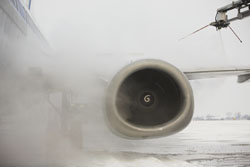Fighting ice build-up on aircraft wings
Icing is perhaps most dangerous when it occurs on wings, disrupting airflow and causing a stall. Ice protection systems (IPSs) are thus safety-critical components of aircraft and the aerospace industry is focusing on them to increase airline safety. One common IPS exploits engine bleed air, or compressed high-temperature air from the engine, to de-ice critical aircraft components, including the wing leading edges. Two alternatives for mid- to large-sized aeroplanes are electrothermal and electromechanical (electromechanical expulsion) systems. The former is quite effective but uses a lot of energy, whereas the latter is energy efficient and often preferable when generator size is an issue or less power is available. Neither system is ideal for all wing types. The EU-funded project 'Development of a slat with integrated electrical deicers for icing wind tunnel tests' (SIEDIT) investigated combinations of technologies or hybrid IPSs for large platforms and wings. Preliminary investigations demonstrated that the two individually optimised sub-systems could not be combined simply but required alterations in each configuration for compatibility. A comprehensive experimental testing and modelling campaign pointed the way to the necessary modifications. Wind tunnel test campaigns at the National Aeronautics and Space Administration (NASA) Glenn Icing Research Tunnel consisted of dry-air conditions up to 140 degrees Celsius and de-icing conditions at – 9 and – 15 degrees Celsius. Test results combined with post-test non-destructive and subsequent destructive inspection highlighted areas for future research. SIEDIT scientists made important progress toward realisation of a hybrid electrothermal and electromechanical IPS for improved safety of medium- to large-sized aeroplanes. Continued research is expected to lead to optimisation and eventual certification.







